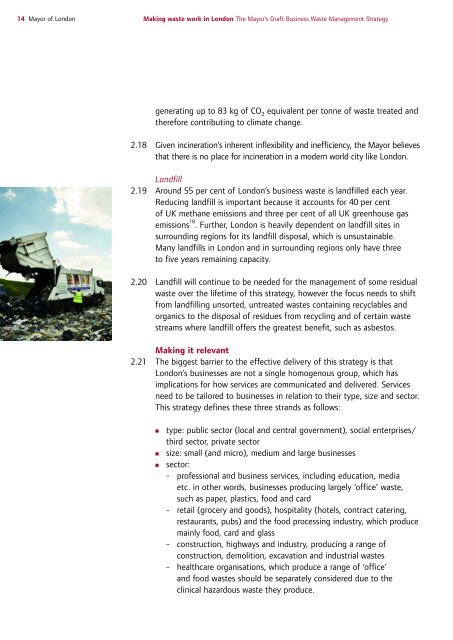Draft Business Waste Strategy PDF - london.gov.uk - Greater ...
Draft Business Waste Strategy PDF - london.gov.uk - Greater ...
Draft Business Waste Strategy PDF - london.gov.uk - Greater ...
You also want an ePaper? Increase the reach of your titles
YUMPU automatically turns print PDFs into web optimized ePapers that Google loves.
14 Mayor of London<br />
Making waste work in London The Mayor’s <strong>Draft</strong> <strong>Business</strong> <strong>Waste</strong> Management <strong>Strategy</strong><br />
generating up to 83 kg of CO 2 equivalent per tonne of waste treated and<br />
therefore contributing to climate change.<br />
2.18 Given incineration’s inherent inflexibility and inefficiency, the Mayor believes<br />
that there is no place for incineration in a modern world city like London.<br />
Landfill<br />
2.19 Around 55 per cent of London’s business waste is landfilled each year.<br />
Reducing landfill is important because it accounts for 40 per cent<br />
of UK methane emissions and three per cent of all UK greenhouse gas<br />
emissions 18 . Further, London is heavily dependent on landfill sites in<br />
surrounding regions for its landfill disposal, which is unsustainable.<br />
Many landfills in London and in surrounding regions only have three<br />
to five years remaining capacity.<br />
2.20 Landfill will continue to be needed for the management of some residual<br />
waste over the lifetime of this strategy, however the focus needs to shift<br />
from landfilling unsorted, untreated wastes containing recyclables and<br />
organics to the disposal of residues from recycling and of certain waste<br />
streams where landfill offers the greatest benefit, such as asbestos.<br />
Making it relevant<br />
2.21 The biggest barrier to the effective delivery of this strategy is that<br />
London’s businesses are not a single homogenous group, which has<br />
implications for how services are communicated and delivered. Services<br />
need to be tailored to businesses in relation to their type, size and sector.<br />
This strategy defines these three strands as follows:<br />
■ type: public sector (local and central <strong>gov</strong>ernment), social enterprises/<br />
third sector, private sector<br />
■ size: small (and micro), medium and large businesses<br />
■ sector:<br />
- professional and business services, including education, media<br />
etc. in other words, businesses producing largely ‘office’ waste,<br />
such as paper, plastics, food and card<br />
- retail (grocery and goods), hospitality (hotels, contract catering,<br />
restaurants, pubs) and the food processing industry, which produce<br />
mainly food, card and glass<br />
- construction, highways and industry, producing a range of<br />
construction, demolition, excavation and industrial wastes<br />
- healthcare organisations, which produce a range of ‘office’<br />
and food wastes should be separately considered due to the<br />
clinical hazardous waste they produce.
















